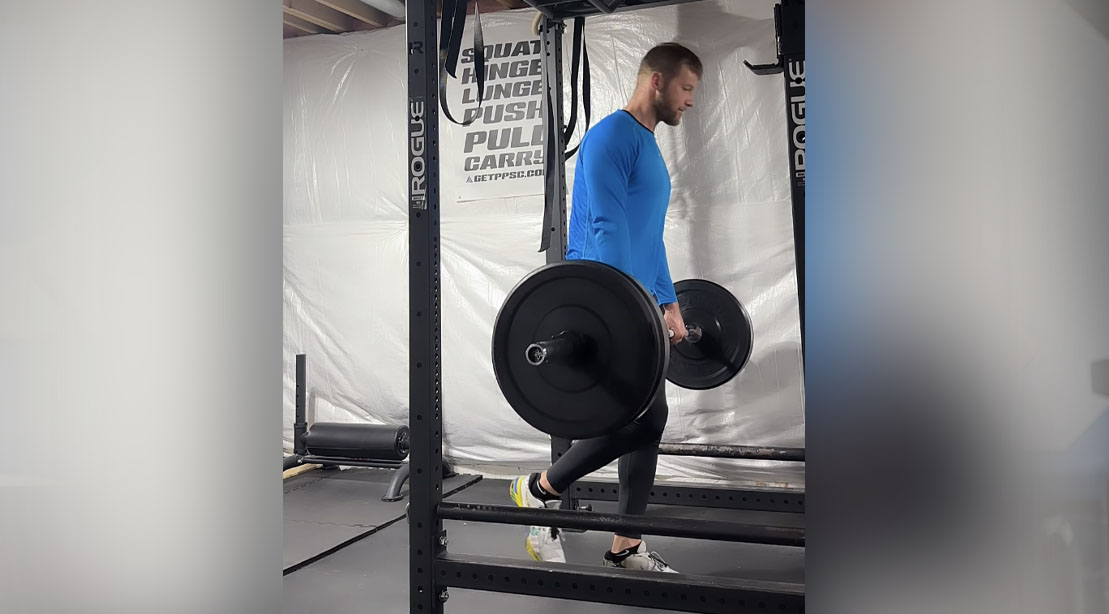Some exercises never get easier no matter how often you do them, and exhibit A is the single-leg deadlift. The balance demands and tension on one leg make this challenging for all lifters the same goes for its variations such as the rack single-leg deadlift.
There are various methods to make the single-leg deadlift less difficult, like using a Landmine device or holding on to a squat rack for improved stability. These are great ways to build single-leg strength and reduce strength imbalances without falling flat on your face.
Then there is this innovative single-leg deadlift variation by Justin Farnsworth that reduces the range of motion and has an assist from the non-working leg for a more powerful hip extension.
But why listen to him? Dr. Farnsworth is a Physical Therapist and a Board-Certified Sports Clinical Specialist. He is also the current director of Rehab for the Pain-Free Performance Specialist (PPSC) and has led over 125 in-person education courses for fitness and allied health professionals. In addition, he practices what he preaches and is one strong doctor.
Are you ready to level up your glutes and increase your single-leg strength with the rack single-leg deadlift? If so, let’s explore this excellent hinge variation.
Single-Leg Deadlift Benefits
Along with single-leg squats, single-leg deadlifts are the gold standard for improving unilateral leg strength. But this gold standard comes with a price because they are both really hard. Dr. Farnsworth outlines the benefits and shortcomings of performing single-leg deadlifts.
“SLDL allows you to achieve a single-leg hinge pattern, a fundamental component of any human movement system. It combines an asymmetrical stance, which is how we spend nearly all of our upright time, and it improves the power and strength of the posterior chain,” says Farnsworth.
But there is a catch, according to the doctor.
“If your balance is excellent, it can be a great way to target unilateral hamstring and glute strength and improve strength asymmetries. That being said, it is not an exercise I perform commonly, as people are too busy trying not to fall over, and it becomes much more balance-based than strength-based exercise,” explains Farnsworth.
Introducing the Rack Single-Leg Deadlift
Dr. Farnsworth explains how to make your SLDL more athletic and improve your unilateral strength.
“ The rack single-leg deadlift setup is unique because it requires a powerful hip extension with a pre-lengthened hamstring muscle. This differs from a top-down RDL, which starts with a shortened hamstring. There is also a transition phase from one to two legs upon concentric pull, which allows an extra point of stability and emphasizes a relatively powerful hip extension. This allows the lifter to use more weight than other true single-leg exercises.” says Farnsworth.
In layman’s terms, Sir-Mix-A-Lot would approve of this variation.
Rack Single-Leg Deadlift Form Tips
Here are some doctor-approved tips to get the most out of this variation.
- Set the bar as low as possible without compensating from your lower back (i.e., you are not gaining more range because the lower back is flexing).
- The barbell should rest against your shin. Hold it tight to your body by squeezing each armpit to your torso.
- Have the rear leg floating in the back (knee bent is OK; we are not gymnasts here)
- Pull the slack out of the bar and POP up as fast as possible (think about driving the hips forward as hard as possible) while allowing the back foot to toe to touch down next to the working foot.
- Slowly return to the starting position, reset, and repeat.
Sets and Reps Suggestions
Dr. Farnsworth states this is power/strength-based, so he prefers five sets of three to six reps per side with 90 seconds of rest.
